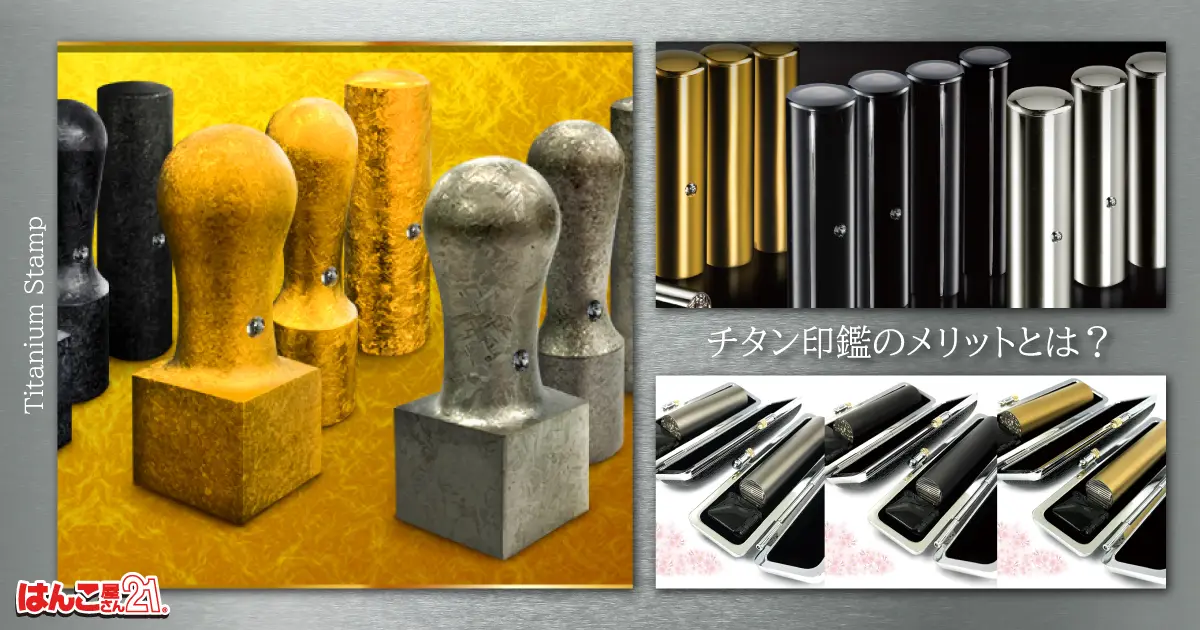When you run a company or store, you have the opportunity to use HANKO and stamps on a daily basis.
There are broadly five types of corporate HANKO used for business at companies and shops, and they are divided according to purpose: representative seal, bank seal, square seal, company recognition seal, and rubber stamp.
For those who are not familiar with it, it may be difficult to understand what a HANKO is used for. In this article, we will introduce the types of corporate HANKO and how to use them.
What is a corporate HANKO?
A corporate HANKO is a HANKO that is stamped on documents for business contracts and government procedures in the business of a company or corporation.
It is sometimes called a company seal, company seal, or corporate seal, and refers to all HANKO used in the business of a company or corporation.
Corporate HANKO have multiple types and names depending on their purpose and shape, and there are many cases where they are mixed and used incorrectly. Some HANKO have a round or square impression after being stamped, and some have characters engraved on them that are difficult to read to prevent forgery.
There are some highly important HANKO , such as HANKO that publicly certify the decisions of a company or corporation's representative, and HANKO used for bank procedures related to company assets, so they must be handled and stored with great care. not.
Types of corporate HANKO
There are five types of corporate HANKO: representative seals, bank seals, square seals, company recognition seals, and rubber stamps.
Representative seal (registered company seal)
This is the HANKO . The company's registered seal is also sometimes called a round seal because the shape of the seal is round.
The representative seal is a HANKO registered with the Legal Affairs Bureau, and affixing the representative seal to contracts, etc. has the effect of publicly proving the intentions and decisions of the company representative.
The design of the seal is made up of double circles. The title name, such as the representative director seal, is engraved on the inside (in Chinese characters), and the company name and trade name are engraved on the outside.
Once you register it as a registered seal with the Legal Affairs Bureau, you will be able to issue a HANKO certificate.
bank seal
This HANKO is as important as the representative seal. Used to notify the bank when opening a corporate account.
The seal is round in shape and is similar to the representative seal, but the inside of the circle (medium letters) is often a bank seal.
Although it is possible to use the representative seal as the bank seal, we recommend that you create and store the representative seal and the bank seal separately to avoid the risk of theft, loss, forgery, etc.
square seal
This is the HANKO most often used for documents issued by a company in daily business. It is called a square seal because of HANKO shape.
In addition to internal documents, it is also used when you want to show that the document is an official document issued by a company or store, such as an estimate or invoice issued externally.
Registration with a government office is not required, so creation is optional, but stamps are more frequently stamped than representative seals or bank seals, and having a square seal increases the reliability of the document.
Registration seal (official seal)
Similar to how personal seals are used, this is a HANKO that is stamped when a registered seal is not specified.
Since it is not registered with a government office or bank, there is no problem with using a square seal, but it is better to make it with a title such as "director's seal," "managing director's seal," "managing director's seal," "branch manager's seal," or "branch manager's seal" in Chinese letters. It is used as a seal to prove that a specific person in charge within the company has approved it.
It is also called a position seal because it is a HANKO with the title of the person in charge. In order to make it easier to tell the difference between a registered seal and a bank seal, it is sometimes created as a slightly smaller round stamp.
rubber stamp
The main rubber stamps created by companies are address stamps, which are stamps that include the company name, store name, trade name, address, TEL, etc. A rubber stamp that can be used for a wide variety of documents such as invoices, estimates, receipts, and envelopes.
In addition to address stamps, there are a wide variety of other types, such as square stamps made of rubber stamps, and data stamps that print contact information such as "Urgent" or "Delivery note included" or the date of issue/confirmation depending on the purpose. there is.
You can customize the rubber stamp that is most suitable for your business use and the size of the stamp field, making your business more efficient.
How to stamp a corporate HANKO
There are different names for how to stamp a corporate HANKO, so be sure to check them.
Seal
Stamping refers to stamping a HANKO near the area where the company name or name is written. To be more precise, it is an abbreviation for "name and seal".
As stated, the company name and full name do not necessarily have to be handwritten. If you are instructed to affix your seal, all you have to do is affix HANKO where the company name and name are already printed.
By the way, there are stamps on words with similar meanings. The word kan is an abbreviation for ``signature and seal,'' and it has the meaning of a set that includes a handwritten signature and a seal. A stamp with a HANKO signature is more authentic as an objective method of proof than a stamp that is simply stamped with a seal.
Seal
A seal refers to stamping a HANKO across multiple pages of a contract to indicate that it is one contract.
This is effective in preventing parts of contract documents from being removed or their contents being tampered with.
All HANKO used will be the ones that signed and affixed the HANKO to the contract. Regarding the method of stamping, if the contract is stapled, fraud can easily occur if it is removed, so stamp it on the double-page spread of the contract so that it spans both pages. However, in the case of a bound contract, it is sufficient to affix the seal across the binding tape, and there is no need to affix the seal on every page.
tally impression
A stamp is a stamp used to indicate that the original and duplicate copies are paired. This has the effect of preventing one party from falsifying the contents or partially destroying the contract.
Place the original contract and the duplicate contract on top of each other and place your seal across both contracts. It is a good idea to place a stamping mat underneath to ensure that the stamp is firmly stamped so that the stamp does not become thin and difficult to read due to the differences in the paper.
Please note that if you fail to affix your seal, it is taboo to affix your seal again. The reason is that it is difficult to read and there is a risk that it will not be possible to verify the seal impression. Make sure to affix double lines or overlapping stamps, discard the impression, and affix a new stamp in a different location.
postmark
A postmark is a seal used to indicate that a revenue stamp or stamp has been used. This is effective in preventing fraud in which revenue stamps and stamps are reused. Documents that require a postmark are stipulated by the Stamp Tax Act, and include transaction contracts, consumer loan contracts, and beneficiary certificates such as stock certificates. However, documents used for government offices and postal mail will not be postmarked. The receiving party will stamp the document, so please be careful not to stamp it yourself without the other party's confirmation.
correction mark
A correction stamp is a stamp that is used to correct errors in document content. This is effective in proving that the document corrections were made with the confirmation of the contractor. Draw a double line over the incorrect part, write the correct content, and stamp the part that overlaps the double line or next to the correct entry. You can make the correction more polite by writing the details of the correction, such as "delete three characters, add four characters", next to the part where you stamped the correction seal.
stamp
A stamp is a correction stamp that is placed on the contract in advance. By affixing a stamp, you will be able to request and approve corrections from the other party even if you do not have the contract with you. Generally, a stamp is placed at the top of the contract, but some documents may have a space prepared in advance for the stamp. If there are multiple subscribers, stamps for all subscribers will be required. This is because corrections must be made with the consent of all contracting parties. It is also necessary to use the same HANKO that was used to sign the contract, so be careful when stamping the contract.
How to register a corporate HANKO
We will explain how to register a corporate HANKO.
Corporate HANKO that can be registered
The only corporate HANKO that can be registered is a representative seal called a round seal. When establishing a company, it is common to apply for HANKO registration along with registration procedures. Once the registration of a corporate HANKO is accepted, a HANKO certificate can be issued, and it becomes possible to publicly prove that the registered HANKO is the intention and decision of the company's representative. Therefore, in some cases, a HANKO HANKO certificate is required for important transaction contract procedures. There are regulations for HANKO that can be registered, and the size of the seal must fit within a rectangle with a side of 1 cm or more and 3 cm or less.
Registered at the Legal Affairs Bureau
Registration of a corporate HANKO is done at the Legal Affairs Bureau that has jurisdiction over the address where the corporation will be established. By completing the application for registration of corporation establishment, notification of corporate HANKO, and application for issuance of a HANKO card as a set, you can avoid having to go through the procedures twice. If you have a HANKO card, you can shorten the procedure for issuing a HANKO certificate, so don't forget to apply. The application form can also be downloaded from the Legal Affairs Bureau website.
Materials required for registration
To register a corporate HANKO, in addition to the notification form and the corporate HANKO, you will also need documents to prove your identity. Specifically, it is the notifier's personal registered seal and a HANKO certificate of the individual's registered seal. HANKO certificates for individuals' registered seals are issued by each local government, not the Legal Affairs Bureau, so please keep this in mind when preparing the necessary materials.
HANKO registration is not required for online procedures
In order to promote the spread of electronic signatures, the obligation to register corporate HANKO was abolished from February 15, 2021. Although it is no longer mandatory, it is now possible to register voluntarily. However, in reality, electronic signatures are not that widespread, and there are cases where a corporate HANKO certificate is required for important contracts. Although it is optional, there are many situations in which it is necessary, so it is best to register a corporate HANKO and obtain a HANKO card at this time.
Points to note about corporate HANKO
Finally, we would like to introduce some important points regarding corporate HANKO.
Be careful about size
Please pay attention to the size when creating a corporate HANKO. In particular, as mentioned above, there are size regulations for representative seals when registering them with the Legal Affairs Bureau. Additionally, in order to distinguish it from other corporate HANKO, it is common practice to refrain from creating them in the same size. We recommend creating the most suitable size for each, such as 18mm for representative stamps, 16.5mm for bank stamps, and 24mm for square stamps.
Be careful when storing
The importance and frequency of use of corporate HANKO vary depending on the type. Please store and manage it carefully. To prevent counterfeiting and unauthorized use, store representative seals and bank seals in separate locations, and also manage the users.
summary
We explained the types of corporate HANKO. There are different types of corporate HANKO, each with different names and uses. Use this article as a reference to avoid work errors caused by differences in perceptions between employees. Even if the other person does not know about HANKO, there is no problem as long as you do. Please check for yourself whether it is correct or not.
 日本語
日本語 English
English 简体中文
简体中文 繁體中文
繁體中文 한국어
한국어 ไทย
ไทย Tiếng Việt
Tiếng Việt Indonesia
Indonesia Français
Français Español
Español Português
Português




